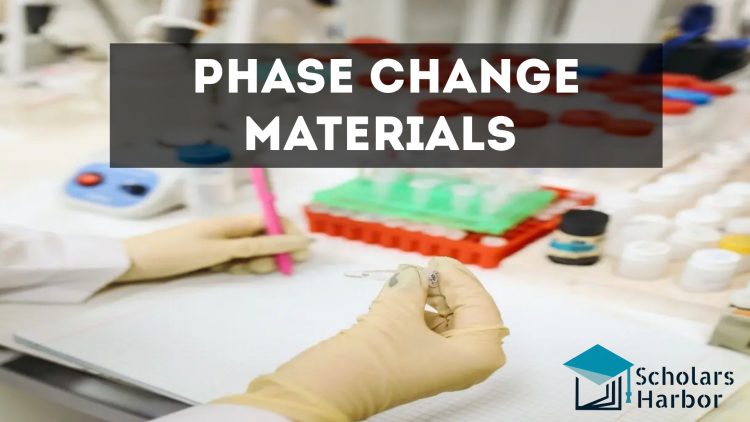The need for energy conservation has grown in significance for human activity. The thermal energy that comes from natural sources is typically regarded as energy of low quality and is typically considered waste in industrial manufacturing. Despite the fact that thermal energy from the sun is continuously abundant during the day, a significant amount is frequently lost. Usage of fossil fuels can be decreased, which significantly decrease the present energy & decrease the environmental issues, if plentiful thermal-energy can be stored & released during supply & demand cycles.
Techniques for storing thermal-energy are divided into 3 categories: thermochemical-energy storage, sensible heat storage, & latent heat-storage. In contrast, Latent heat storage employing PCMs is thought to be better alternative since it can reversibly store & release significant amounts of thermal-energy derived from the external environment with little change in temperature throughout the phase change process.
What is PCM ?
A phase change material is a substance that releases or absorbs enough latent energy during a phase transition to deliver usable heating or cooling. When compared to sensible storage materials, PCMs often have a higher storage density due to their high heat of fusion. The temperature variation is quite small throughout the phase transition process, which can benefit in maintaining the Heat transfer fluid at its phase change temperature.
Classification of PCMs
Due to their diverse physical and chemical features, a wide range of compounds are used as phase change materials for several applications. There are three main categories of PCMs
- Organic
- Inorganic
- Eutectic
01: Organic PCMs
Organic PCMs can be non-paraffinic, such as fatty acids, esters of fatty acids, glycolic acids & alcohols etc. or paraffinic, like paraffin wax, which is the most widely utilized organic PCM. Hydrocarbon chains make up paraffinic PCMs, although electronegative atoms are also included in the chains of non-paraffinic PCMs. Hydrocarbon chains of 8 to 15 carbon atoms make up paraffin waxes, and chains with 14 to 40 carbon atoms make up pure paraffin.
Non-paraffinic PCMs can be produced using BioSource raw materials such animal fats and vegetable oils. These materials are less flammable and poisonous. However, their main disadvantages are that they are more expensive and corrosive than paraffin. Organic PCMs display a wide range of benefits. First of all, a wide range of temperatures are available for a variety of applications since the phase change temperature increases in direct proportion to the number of C-atoms in the chain. Some of the advantages of organic PCMs are
- No corrosion or sub cooling problems.
- Chemical stability and good compatibility with various PCM container types.
- Meets application requirements and is available in necessary temperature ranges.
- High Compatibility with nano & micro-capsulation techniques.
02: Inorganic PCMs
Metals and hydrated-salts are 2 categories of inorganic chemicals that can be employed as PCMs. The use of hydrated salts as PCMs has received extensive research. Low melting metals are included in the metal category, however they have not yet undergone extensive PCM research.
The highest qualities of inorganic PCMs are their high energy efficiency and thermal conductivity. Other benefits include their flammability and low volume change during phase transition. Some of the advantages of Inorganic PCMs are
- High thermal conductivity and excellent latent heat.
- Minimal volume changes occur when substances melt and solidify.
- Non Flammable
- Low cost and easily accessible
- High energy efficiency
03: Eutectic PCMs
The eutectic is produced when 2 or more organic, inorganic, or both PCM substances combined. This method allows for the creation of an infinite number of eutectic mixes. This opens up the opportunity of creating a material with the desired thermal characteristics, such as phase change temperature and latent heat.
The most significant benefit of eutectic mixtures is the capacity to produce a material with the appropriate phase transition temperature for any application. Comparing eutectic mixes to inorganic/inorganic or inorganic/organic combinations, certain extra benefits can be seen. Some of the advantages of Eutectic PCMs are
- Resembling a pure substance, have a sharp phase change temperature
- Greater thermal conductivity than other types of PCMs
- Extremely high thermal storage density per unit volume
- Eutectic PCMs having long term stability
- High chemical compatibility.
Encapsulation of PCMs
An effective PCM thermal storage system should have high heat exchange surface for transferring heat from the heating element to the PCM and from the PCM to the heat sink as well as an appropriate container for the PCMs. Encapsulation is crucial for the PCMs proper operation. There are two types of encapsulation
- Macro-encapsulation
- Micro-encapsulation
01: Macro-encapsulation
In micro-encapsulation, tiny PCM particles with spherical or rod shapes are encased in a thin, solid shell. These particles range in size from 1μm to 1000μm.
02: Micro-encapsulation
The second technique is called macro-encapsulation, and it entails placing PCM inside of a packaging made of tubes, tiny bags, spheres, panels, or some other type of container. From a few milliliters to several liters of PCM can be found. Today, macro-capsulated PCMs are the most popular.
Cite this Article
| Author: | Scholars Harbor |
| Year: | 2022 |
| Title |
Phase Change Materials and its Classification – Explained |
| Publisher: | Scholars Harbor |
| URL: | https://scholarsharbor.com/phase-change-materials-and-its-classification-explained/ |













Discussion about this post